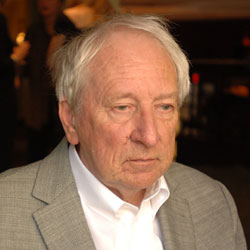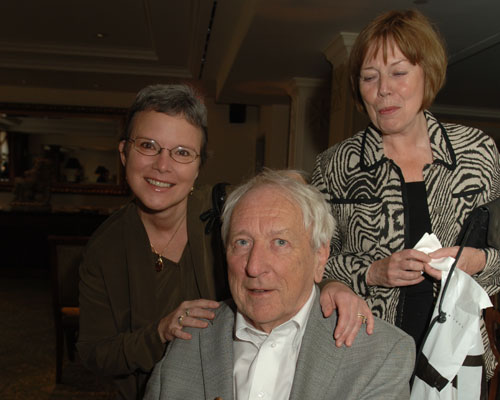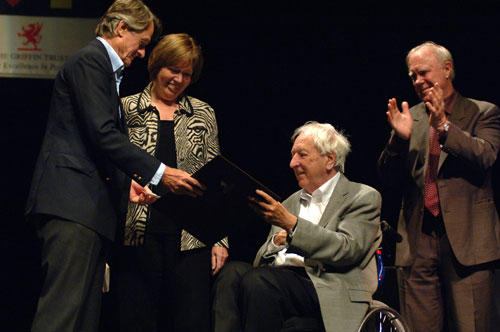Lifetime Recognition Award, 2007
We extend warmest congratulations to Tomas Tranströmer, winner of the 2011 Nobel Prize in Literature.
On June 5, 2007, The Griffin Trust for Excellence in Poetry bestowed its second Lifetime Recognition Award on the renowned poet Tomas Tranströmer.

Tomas Tranströmer, perhaps the best-known modern Scandinavian poet, was born in 1931 in Stockholm, Sweden. Few poets have been more widely translated; his work has appeared in no fewer than 50 languages. His influence, notably on North American poets, has been profound. The reason for this international appeal may be found in Tranströmer’s highly original lyrical and surrealistic imagery, work that finds its seeds in and further develops the Modernist and Expressionist/Surrealist language of 20th century poetry. His work is rife with juxtapositions of contrary and primal forces firmly rooted in the natural world, falling somewhere between dream and nightmare.
Tranströmer was the child of a broken home, perhaps instilling in him a nascent poetic empathy and explaining his later work as a psychologist specializing in the treatment of the disabled, convicts, and drug addicts. Tranströmer’s father was a journalist, his mother a teacher. As a young boy, he spent many summers on the island of Runmarö and in his poetry collection Östersjöar (1974, Baltics) and memoir Minnena ser mig (1993, The Memories are Watching Me) he returns to its landscape. While Tranströmer would ultimately become interested in music and painting, he was initially fascinated by entomology, geography, and the natural sciences and wanted to become an explorer. The natural world, in all its guises, figures prominently in his poetry.

Tranströmer was educated at Södra Latin School, where he started to read and write poetry. In 1956 he received a degree in psychology from the University of Stockholm. He worked for the University’s Psychotechnological Institute and in 1960 he became a psychologist at Roxtuna, an institution for juvenile offenders.
By the mid-1960s Tranströmer had begun to divide his time between his writing and his work as a psychologist. In 1965 he moved with his family to Västerås, a city about sixty miles west of Stockholm. In 1980, he took a job as a psychologist for Arbetsmarknadsinstitutet, a labor organization.
Though Tranströmer began composing poetry at the age of 16, he made his debut as a published poet at the age of 23 with 17 dikter (1954, 17 Poems), which included poems written in blank verse. At times Tranströmer has experimented with metre, although he customarily uses free verse in most of his work. Hemligheter på vägen (1958, Secrets on the Way) and Klangar och spår (1966, Windows and Stones) takes up themes from Tranströmer’s travels in different parts of the world – the Balkans, Spain, Africa, and the United States.
Tranströmer’s poems are often built around his own experience, around clear, ostensibly simple pictures from everyday life and nature, revealing mystical insights into the universal aspects of the human mind and opening doors to complex psychological conceits and metaphysical interpretations. Mörkseende (1970, Night Vision) explores a critical juncture in the poet’s personal life, as well as a preoccupation with death and disease among his kin.
Stigar (1973, Paths) consists of Tranströmer’s own poems and translations of poems by Robert Bly and János Pilinszky. Bly, a friend and fellow poet, has read with Tranströmer at many American universities, and has translated a number of Tranströmer’s poems into English. In 2001 the publishing company Bonniers celebrated the poet’s 70-year birthday with Air Mail, a selection of correspondence from 1964 to 1990 between these two famed writers, confidantes and friends.

In 1989, Tranströmer’s 10th collection, För levande och döda (For the Living and the Dead) was published. In 1990 he suffered a stroke. After a prolonged silence, Tranströmer returned with Sorgegondolen (1996, The Sad Gondola), which takes its title from Franz Listz’s two piano pieces. Tranströmer’s musical interests are prominent in many of his collections, as though he feels constrained by the limits of expression through poetry alone. An accomplished amateur musician, Tranströmer delighted audiences at the 2006 South Bank Poetry International when he played two small piano pieces using only his left hand.
Tranströmer’s numerous honours and awards include the Aftonbladets Literary Prize, the Bonnier Award for Poetry, the Neustadt International Prize for Literature, the Oevralids Prize, the Petrach Prize in Germany, the Bellman Prize, The Swedish Academy’s Nordic Prize, the August Prize and the International Poetry Forum’s Swedish Award. In 1997, the city of Västerås established a special Tranströmer Prize.
His latest collection, Den stora gåtan (The Big Riddle), was published in 2004, and Robin Fulton’s English translation of Tranströmer’s entire body of work, The Great Enigma: New Collected Poems, was published in 2006.
“We note with particular sadness that one of the world’s great poets has died.” – Scott Griffin
The Griffin Trust For Excellence In Poetry was deeply saddened to learn of the passing of Nobel Prize-winning Swedish poet Tomas Transtromer on March 26, 2015. The Griffin Trust was honoured to welcome Tomas and Monica to Toronto and to the Griffin Trust family when he received our Lifetime Recognition Award in 2007. We turn now to his moving poetry for solace at the loss of such a great artist and friend.
-
Sweden’s Nobel-winning poet Tomas Transtromer dies at age 83
The reclusive, mild-mannered wordsmith was considered a master of metaphor and one of the most important Scandinavian poets of the post-World War II era.
(Toronto Star) -
Tomas Transtromer: Poet and Nobel Literature Prize winner dies
(The Independent) -
Tomas Transtromer, Nobel laureate, dies at 83
(Los Angeles Times) -
Swedish poet Tomas Tranströmer dies aged 83
Nobel Prize winner and psychologist passes away in Stockholm after a short illness
(The Guardian)
Photos by Tom Sandler
2 Replies to “2007 – Tomas Tranströmer”